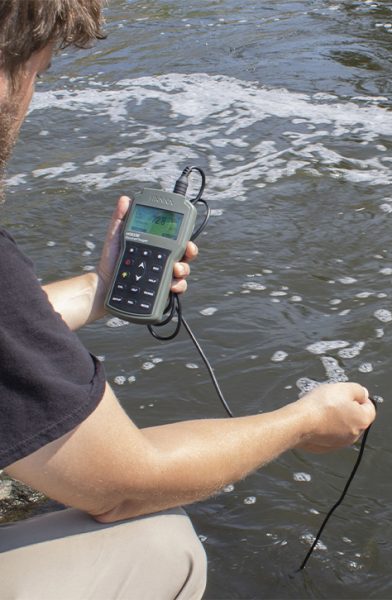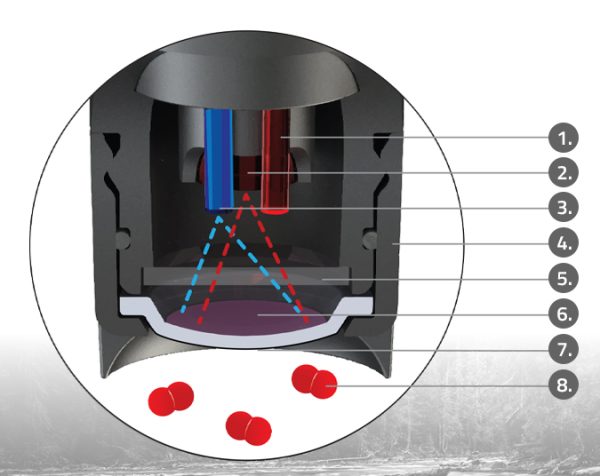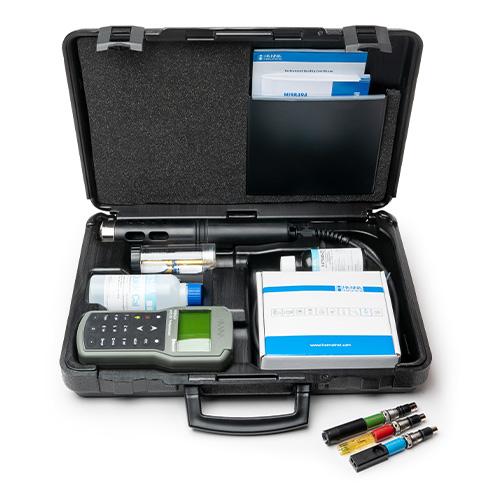Fast
Simple
Reliable
Natural ponds or lakes are considered to be fragile ecosystems, where the smallest changes can have a big impact. Optimal water quality is definitely the essential to maintain the ecosystem and ensure a healthy life of the fish living in it. Therefore, fish farmers or aquarists depend on constantly checking certain parameters in the water. Probably the most important parameter by far is dissolved oxygen (DO).


It refers to the level of free, unbound oxygen in water or other liquids. This free oxygen is therefore not bound to any other element and provides information about the water quality, as it directly influences the living organisms in the water. In an aquaculture or a pond, the DO value should be between 5 and 12 mg/l (ppm). Among other things, it is essential for the photosynthesis of phytoplankton and is therefore the basis of a functioning food chain. An oxygen saturation of 60-70% is required for a healthy ecosystem and healthy fish.
The established electrochemical DO measurement is gradually being replaced by the optical measurement method. The measurement principle is based on the physical luminescence oxygen measurement. The basis of this measurement is the detection of the fluorescence decrease of a special excited luminophore after excitation by a pulsed blue LED light beam of defined wavelength. The temporal decay behavior after excitation is measured in relation to a red reference LED. This is directly related to the oxygen concentration on the carrier surface.

Sensor
1.Red light: reference source
2.Photodetector
3.Blue light: excitation source
4.Smart cap
5.Optical window
6.Fluorescent luminophore
7.Black protective layer
8.Oxygen molecules
Sensor
Red light: reference source
Photodetector
Blue light: excitation source
Smart cap
Optical window
Fluorescent luminophore
Black protective layer
Oxygen molecules
Advantages
Established electrochemical dissolved oxygen measurement methods require maintenance performed by the user on a regular basis. Cleaning, calibration, membrane and electrolyte changes, polishing of the anode and the documentation of these activities were considered to be necessary and unavoidable.
With the innovative, optical measuring method, an alternative is available. Compared to the electrochemical measuring method, there are considerable advantages for the user when using the optical method with regard to the quality of the measured values and the required maintenance effort.


*The optical method for measuring dissolved oxygen eliminates the process-related disadvantages of traditional electrochemical measurement methods*
- No membrane – and electrolyte changes
Optical DO probes work without membrane and electrolyte.
- No calibration
The optical measurement method attributes the measurement of the oxygen concentration to a drift-free measurement of time. Any wear or fading of the luminescent material on the sensor cap will affect the intensity, but not the lifetime of the red emitted radiation. This is determined solely by the oxygen concentration of the sample. All optical components are adjusted before each measurement by the light pulse of the red reference LED, which exactly follows the beam path of the luminescent radiation. Faulty calibrations by the user are excluded.
- High measurement accuracy
The high-energy blue excitation light guarantees the consistently high measurement accuracy of the sensors.
- No incident flow
Electrochemical measurement techniques evaluate the current flow or voltage caused due to the reduction of oxygen to hydroxide ions at the cathode. To compensate for this “oxygen consumption”, a constant diffusion of oxygen molecules into the electrolyte is required. The depletion of oxygen molecules immediately in front of the sensor can only be prevented from flowing sample against the sensor. No oxygen molecules were consumed in the optical measurement process.
- Short response times
In the optical method, the oxygen molecules only have to be in contact with the luminophore. The response times of the optical measurement method are therefore in the range of seconds.
- High sensitivity at low oxygen concentrations
The sensitivity of the measurement effect (change in the lifetime of the luminescence radiation / change in the oxygen concentration (Fv /FcO2 )) increases with decreasing oxygen concentration. The measuring principle, therefore exhibits particularly good resolution in the lower measuring range.
Hanna Instruments offers you a professional meter with all the features described.
HI98198
Optical Dissolved Oxygen Meter
The HI98198 is a robust, waterproof and portable measuring instrument for the optical determination of dissolved oxygen. It features extreme ruggedness combined with ease of use and the measurement quality of high quality laboratory instruments.
HI98198 provide accurate and reliable measurements of dissolved oxygen in a range of 0.00 to 50 mg/L and 0.0 to 500.0% saturation, barometric pressure from 420 to 850 mmHg and temperature in a range of -5.0 to 50.0°C.
- No membrane, no electrolyte
- Low maintenance
- Waterproof: Ergonomic, rugged and waterproof (IP67) design that withstands harsh environments.
- Quick Connect Probe: The included HI764113 optical oxygen probe features the Quick Connect DIN connector, which provides a quick and easy waterproof connection to the instrument. The probe’s built-in temperature sensor allows automatic temperature compensation of readings.
- GLP data: The GLP data stored with the measured values can be checked at any time. They include date and time of calibration, as well as pressure, salinity and temperature values.
- Graphic LCD: The high-contrast graphic LC display is easy to read both outdoors in bright sunshine and, thanks to its backlight, in low light. The instrument is intuitive to use thanks to a combination of context-sensitive virtual and fixed keys. Several languages can be selected. In addition, the meter has an intuitive keypad and context-sensitive help.
- Data recording: The on-demand data recording function allows up to 4000 measurements to be stored. The values can later be transferred to a connected PC.
- Long battery life: The HI98198 can run for up to 200 hours on a set of 4 AA batteries. The battery level indicator on the display informs about the remaining lifetime.
- Sturdy carrying case: The HI98198 comes in a sturdy plastic carrying case. It accommodates the device and accessories with a perfect fit.

NEW!
Measure all parameters
simultaneously with only one meter!
simultaneously with only one meter!
HI98494
Portable multi-parameter pH/EC/DO
meter with Bluetooth® technology.
The HI98494 measures pH, ORP, EC, TDS, resistivity, salinity, seawater-σ, dissolved oxygen, atmospheric pressure, and temperature and can display 1 to 12 parameters on the high-contrast, backlit LCD.
- Bluetooth technology: retrieve recorded data with the Hanna Lab app and send it by email or download it to your smartphone
- Waterproof: IP67 rated waterproof housing, probe waterproof to IP68.
- Digital probe with integrated temperature sensor and 3 ports for pH(ORP), electrical conductivity (EC) and dissolved oxygen (optical) sensors; Color-coded, field-replaceable sensors; Automatic sensor detection; Weighted stainless steel protective cap
- Quick calibration
- Automatic barometric pressure compensation
- Automatic temperature compensation
- Data logging: Automatic interval storage of up to 45,000 samples
- GLP: Storage of data from the last 5 calibrations to comply with Good Laboratory Practice
- Graphical display: With the Hanna Lab App there is the possibility to graphically display recorded data.
- Data transfer: Data can be sent by e-mail as a .CSV or .PDF file.
- Dedicated help button: Context-sensitive on-screen help at the touch of a button
- Backlit LC display
- Intuitive keyboard: Decided keys and virtual multifunction keys
- USB Type-C: Computer port for transferring recording data as a .CSV file; port for charging the built-in lithium-ion battery pack
- Dual power supply: Operation with built-in lithium-ion battery or battery operation with 1.5 V AA; alkaline batteries when battery level is low
- Supplied in a rugged carrying case







